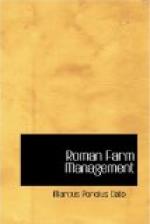Thus there are as many methods of cultivating the vine as there are kinds of soil. For where the land is wet the vine must be trained high because when wine is being made and matured on the vine, it needs sun, not water—as when it is in the cup! For this reason it was, I think, that first the vine was made to grow on trees.
Of the different kinds of soil
IX. It is expedient then, as I was saying, to study each kind of soil to determine for what it is, and for what it is not, suitable. The word terra is used in three senses: general, particular and mixed. It is a general designation when we speak of the orb of the earth, the land of Italy or any other country. In this designation is included rock and sand and other such things. In the second place, terra is referred to particularly when it is spoken of without qualification or epithet. In the third place, which is the mixed sense, when one speaks of terra as soil—that in which seeds are sown and developed; as for example, clay soil or rocky soil or others. In this sense there are as many kinds of earth as there are when one speaks of it in the general sense, on account of the mixtures of substances in it in varying quantities which make it of different heart and strength, such as rock, marble, sand, loam, clay, red ochre, dust, chalk, gravel, carbuncle (which is a condition of soil formed by the burning of roots in the intense heat of the sun); from which each kind of soil is called by a particular name, in accordance with the




